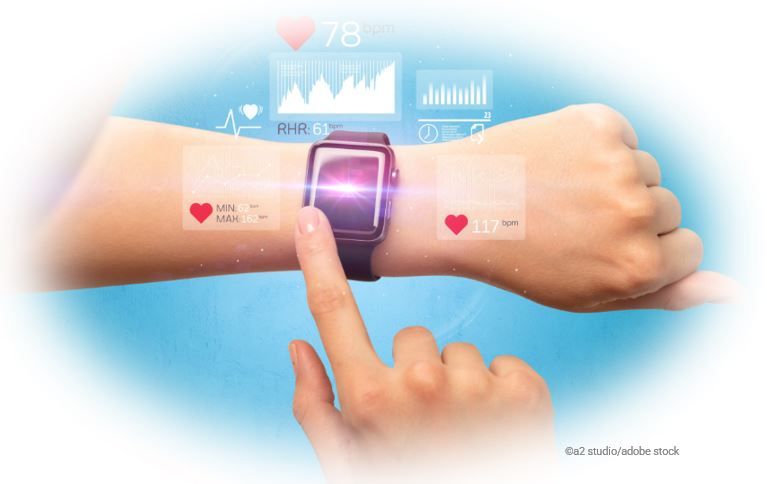Individuals with Atrial Fibrillation Who Use Wearable Devices Report Heightened Symptom Monitoring, Treatment Concerns
Participants with AF who used wearable devices reported higher anxiety levels and increased health care usage than nonusers, according to a new study.

Individuals with atrial fibrillation (AF) who use wearable devices excessively monitor their cardiovascular symptoms and report more concerns about their AF treatment compared to individuals who do not use wearables, according to a new study published in the Journal of the American Heart Association.
In the retrospective, propensity-matched study of 172 individuals with AF (mean age, 72.7 years; 42% women), those who used wearable devices (n = 83) reported higher rates of symptoms monitoring and preoccupation (P = .03) and more AF treatment concerns (P = .02) compared to nonusers. Moreover, researchers reported 20% of wearable users experienced intense fear and anxiety after receiving an irregular rhythm notification and always contacted their clinician in response.
In addition, results showed AF-specific health care use was significantly greater among wearable users (mean 4.05, 95% CI 2.91-5.18) than nonusers (mean 2.70, 95% CI 1.99-3.41; P = .04), with differences in the mean number of AF-specific outpatient visits to cardiology and primary care clinics (users: 2.04, 95% CI 1.51-2.56; nonusers: 1.33, 95% CI 1.01-1.65; P = .02).
The researchers also reported differences in the mean number of rhythm-related diagnostic tests and procedures received by users (1.84, 95% CI 1.27-2.42) and nonusers (1.00, 95% CI 0.62-1.38; P = .004). Specifically, participants who used wearables were significantly more likely to receive ablation procedures (P = .03), ECGs (P = .003), and echocardiograms/transesophageal echocardiograms (P = .04) compared to nonusers.
During the 9-month follow-up period, overall use of informal health care resources was significantly greater among wearable users (mean 5.52, 95% CI 4.08-6.96) compared with nonusers (mean 3.90, 95% CI 3.06-4.72; P = .05). Additional analyses showed that wearable users sent significantly more messages to health care providers (mean 3.59, 95% CI 2.57-4.61) than nonusers (mean 2.41, 95% CI 1.82-3.0; P = .04).
“The current study begins to answer important questions that move beyond whether wearables can safely and reliably detect arrhythmias, to understanding how these devices are being used by diverse segments of the population, and their impact on health care use and overall wellbeing,” first author Lindsey Rosman, PhD, of the Department of Medicine in the Division of Cardiology at the University of Chapel Hill, and colleagues wrote in the study published online July 16, 2024.
Although the use of wearable devices for symptom monitoring and health management among individuals with AF is increasing, little is known about their impact on health care use and psychological well-being, according to investigators. To fill this gap in research, they conducted the current study to analyze the clinical and psychiatric characteristics of individuals with AF who use wearables compared to nonusers.
Rosman and colleagues merged survey and electronic health record data to compare AF-specific health care use (eg, outpatient/inpatient visits, rhythm-related testing, and procedures) and informal health care use (eg, telephone calls, and patient portal messages) over a 9-month period between the 2 groups. They also examined the effects of wearable cardiac monitoring features including heart rate alerts, irregular rhythm notification, and ECG. Individuals were considered wearable users if they reported any history or current use of a wearable device in the survey. Nonusers were included as a control group to compare characteristics and patterns of health care use to individuals with AF who used wearables, according to the study.
“To our knowledge, this study is the first to comprehensively examine how real‐world individuals with AF use wearable devices to monitor their cardiovascular symptoms and manage their health care needs,” researchers wrote.
They added: “Future studies should determine both the positive (eg, improvement in health behaviors, patient engagement, self‐efficacy, confidence in AF self‐care, perceived connection to health care providers, satisfaction with AF care), and negative effects (eg, cardiac‐specific anxiety, somatic preoccupation) of wearables on individuals with AF, as our data show there may be heterogeneity in their effects.”
Reference: Rosman L, Lampert R, Zhuo S, et al. Wearable devices, health care use, and psychological well-being in individuals with atrial fibrillation. JAHA. Published online July 16, 2024. doi:10.1161/JAHA.123.033750